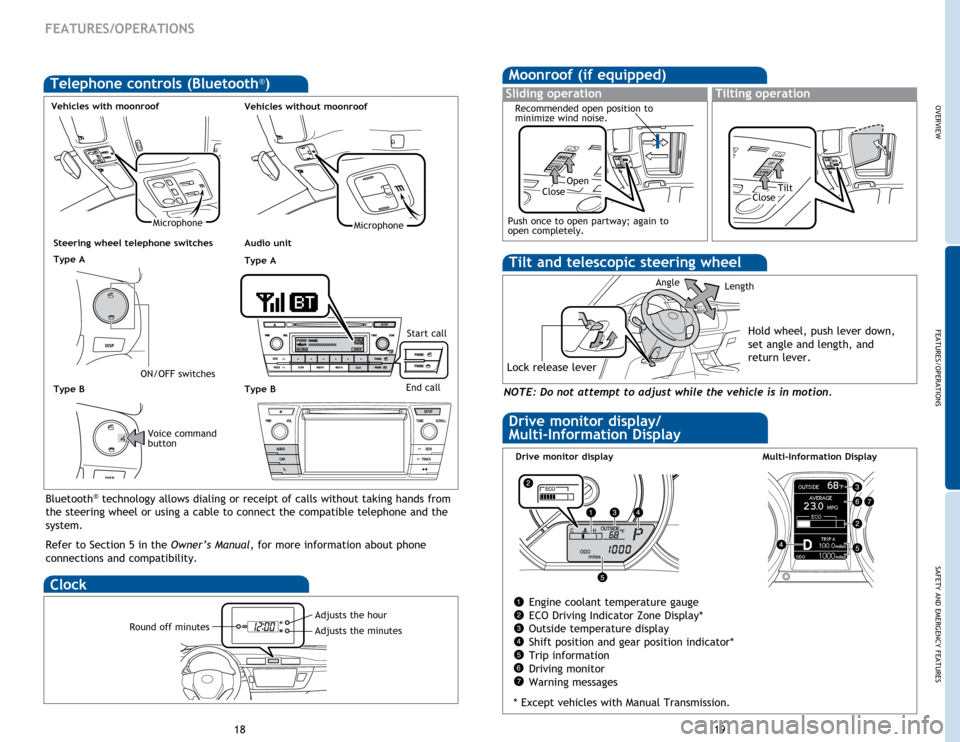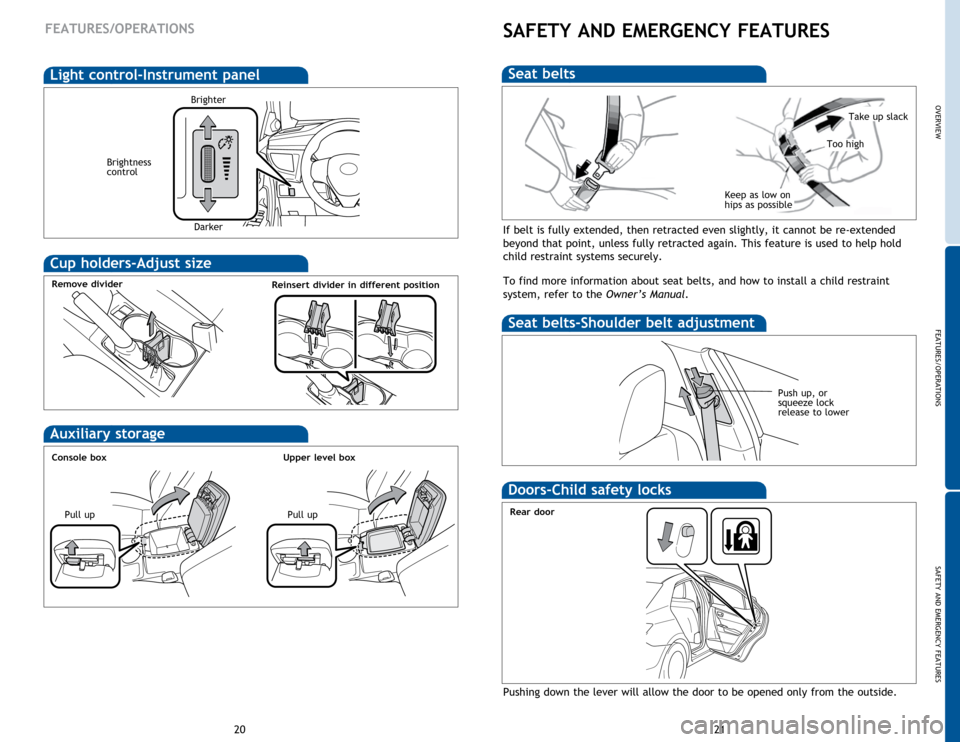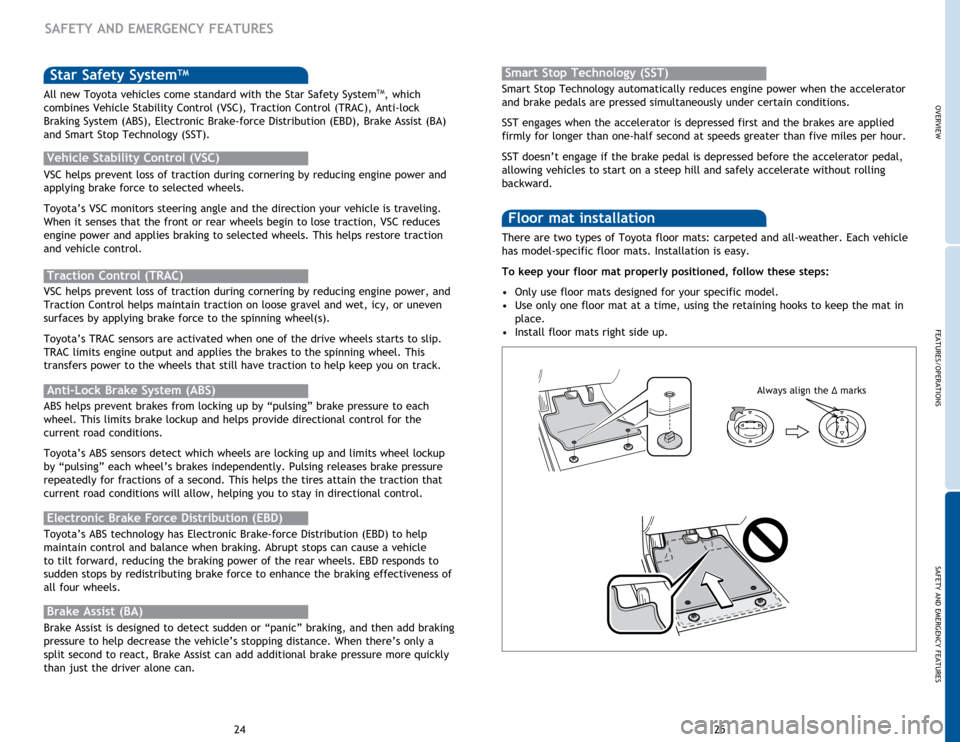TOYOTA COROLLA 2014 11.G Quick Reference Guide
Manufacturer: TOYOTA, Model Year: 2014, Model line: COROLLA, Model: TOYOTA COROLLA 2014 11.GPages: 15, PDF Size: 6.61 MB
Page 11 of 15

OVERVIEW
FEATURES/OPERATIONS
SAFETY AND EMERGENCY FEATURES
19
18
FEATURES/OPERATIONS
NOTE: Do not attempt to adjust while the vehicle is in motion.
Tilt and telescopic steering wheel
Lock release lever
AngleLength
Hold wheel, push lever down,
set angle and length, and
return lever.
Moonroof (if equipped)Telephone controls (Bluetooth®) Sliding operationTilting operation
OpenTiltCloseClose
Recommended open position to
minimize wind noise.
Bluetooth® technology allows dialing or receipt of calls without taking hands from
the steering wheel or using a cable to connect the compatible telephone and the
system.
Refer to Section 5 in the Owner’s Manual, for more information about phone
connections and compatibility.
Vehicles without moonroofVehicles with moonroof
Steering wheel telephone switches
ON/OFF switches
Push once to open partway; again to
open completely.
Type A
MicrophoneMicrophone
Audio unit
End call Start call
Voice command
button
Type B
Engine coolant temperature gauge
ECO Driving Indicator Zone Display*
Outside temperature display
Shift position and gear position indicator*
Trip information
Driving monitor
Warning messages
* Except vehicles with Manual Transmission.
Drive monitor display/
Multi-Information Display
Drive monitor displayMulti-Information Display
Clock
Adjusts the hourRound off minutesAdjusts the minutes
Type B
Type A
Page 12 of 15

OVERVIEW
FEATURES/OPERATIONS
SAFETY AND EMERGENCY FEATURES
21
20
FEATURES/OPERATIONS
If belt is fully extended, then retracted even slightly, it cannot be re-extended
beyond that point, unless fully retracted again. This feature is used to help hold
child restraint systems securely.
To find more information about seat belts, and how to install a child restraint
system, refer to the Owner’s Manual.
Keep as low on
hips as possible
Take up slack
Too high
Seat belts
Push up, or
squeeze lock
release to lower
Seat belts-Shoulder belt adjustment
SAFETY AND EMERGENCY FEATURES
Cup holders-Adjust size
Remove divider
Auxiliary storage
Console boxUpper level box
Reinsert divider in different position
Pull up Pull up
Light control-Instrument panel
Brightness
control
Brighter
Darker
Pushing down the lever will allow the door to be opened only from the outside.
Rear door
Doors-Child safety locks
Page 13 of 15

OVERVIEW
FEATURES/OPERATIONS
SAFETY AND EMERGENCY FEATURES
23
22
SAFETY AND EMERGENCY FEATURES
System reset initialization
1. Push and hold “ SET” button
until the indicator blinks three
times.
2. Wait a few minutes to allow
initialization to complete.
Trunk-Internal release
Push
Spare tire & tools
Tool location
Removing the spare tire
(1) Remove the luggage floor cover.
(2) Remove the tool tray.
(3) Loosen the center fastener that secures the spare tire.
Refer to the Owner’s Manual for tire changing and jack positioning procedures.
Luggage floor cover
Wheel nut wrench
Tool tray
Jack
Jack handle
Spare tire
(1)(2)
(3)
Tire Pressure Monitoring (warning)
System
After adjusting tire pressures, or after tires have been rotated or replaced, turn
the engine switch to “ON” and press and hold the “
SET” button until indicator
blinks three times. Let the vehicle sit for a few minutes to allow initialization to
complete.
Refer to the load label on the door jamb or the Owner’s Manual for tire inflation
specifications.
If the tire pressure indicator flashes for more than 60 seconds and then remains
on, take the vehicle to your local Toyota dealer.
NOTE: The warning light may come on due to temperature changes or changes
in tire pressure from natural air leakage. If the system has not been initialized
recently, setting the tire pressures to factory specifications should turn off the
light.
Page 14 of 15

OVERVIEWFEATURES/OPERATIONS
SAFETY AND EMERGENCY FEATURES
25
24
SAFETY AND EMERGENCY FEATURES
Star Safety SystemTM
VSC helps prevent loss of traction during cornering by reducing engine power and
applying brake force to selected wheels.
Toyota’s VSC monitors steering angle and the direction your vehicle is traveling.
When it senses that the front or rear wheels begin to lose traction, VSC reduces
engine power and applies braking to selected wheels. This helps restore traction
and vehicle control.
Vehicle Stability Control (VSC)
Anti-Lock Brake System (ABS)
ABS helps prevent brakes from locking up by “pulsing” brake pressure to each
wheel. This limits brake lockup and helps provide directional control for the
current road conditions.
Toyota’s ABS sensors detect which wheels are locking up and limits wheel lockup
by “pulsing” each wheel’s brakes independently. Pulsing releases brake pressure
repeatedly for fractions of a second. This helps the tires attain the traction that
current road conditions will allow, helping you to stay in directional control.
Brake Assist (BA)
Brake Assist is designed to detect sudden or “panic” braking, and then add braking
pressure to help decrease the vehicle’s stopping distance. When there’s only a
split second to react, Brake Assist can add additional brake pressure more quickly
than just the driver alone can. VSC helps prevent loss of traction during cornering by reducing engine power, and
Traction Control helps maintain traction on loose gravel and wet, icy, or uneven
surfaces by applying brake force to the spinning wheel(s).
Toyota’s TRAC sensors are activated when one of the drive wheels starts to slip.
TRAC limits engine output and applies the brakes to the spinning wheel. This
transfers power to the wheels that still have traction to help keep you on track.
Traction Control (TRAC)
Electronic Brake Force Distribution (EBD)
Toyota’s ABS technology has Electronic Brake-force Distribution (EBD) to help
maintain control and balance when braking. Abrupt stops can cause a vehicle
to tilt forward, reducing the braking power of the rear wheels. EBD responds to
sudden stops by redistributing brake force to enhance the braking effectiveness of
all four wheels. There are two types of Toyota floor mats: carpeted and all-weather. Each vehicle
has model-specific floor mats. Installation is easy.
To keep your floor mat properly positioned, follow these steps:
• Only
use floor mats designed for your specific model.
• Use only one floor mat at a time, using the retaining hooks to keep the mat in
place.
• Install floor mats right side up.
Floor mat installation
All new Toyota vehicles come standard with the Star Safety SystemTM, which
combines Vehicle Stability Control (VSC), Traction Control (TRAC), Anti-lock
Braking System (ABS), Electronic Brake-force Distribution (EBD), Brake Assist (BA)
and Smart Stop Technology (SST). Smart Stop Technology automatically reduces engine power when the accelerator
and brake pedals are pressed simultaneously under certain conditions.
SST engages when the accelerator is depressed first and the brakes are applied
firmly for longer than one-half second at speeds greater than five miles per hour.
SST doesn’t engage if the brake pedal is depressed before the accelerator pedal,
allowing vehicles to start on a steep hill and safely accelerate without rolling
backward.
Smart Stop Technology (SST)
Always align the
Δ marks
Page 15 of 15

00505-QRG14-COR
Printed in the USA 8/13